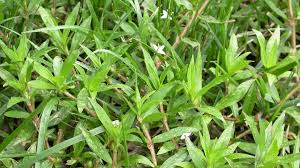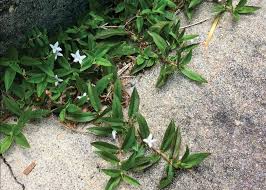Virginia buttonweed is a difficult weed. It invades lawns across many states. This weed is notoriously hard to kill. It spreads aggressively in warm weather. Therefore, homeowners find it frustrating. This guide explains Virginia buttonweed. We will cover its identification. We will also discuss control methods.
Identifying Virginia Buttonweed in Your Lawn
Identifying Virginia buttonweed is the first step. This weed has distinctive features. Its leaves are lance-shaped and green. They grow opposite each other on the stem. The leaves are typically shiny. They can also appear slightly wrinkled. Look for these leaves in your turf. They often form dense, low-growing mats.
Moreover, the flowers are a key sign. Virginia buttonweed produces small, white flowers. They are star-shaped with four petals. Sometimes they have a pinkish tint. These flowers bloom all summer long. You will see them from spring until fall. The flowers grow from the leaf axils. This is where leaves meet the stem.
Furthermore, its growth habit is telling. This weed spreads through multiple means. It grows from roots and stem fragments. It also spreads via seeds. This makes it a formidable opponent. The stems root wherever they touch soil. Consequently, it forms thick patches. These patches can choke out your grass. Proper identification is crucial for control.
The Life Cycle of Virginia Buttonweed
The life cycle of Virginia buttonweed is complex. It is a warm-season perennial weed. This means it comes back each year. It thrives in hot, humid weather. The weed emerges in late spring. It grows actively throughout the summer. Then, it goes dormant in winter. Its roots survive the cold underground.
For instance, its reproduction is very effective. It produces seeds above the ground. It also produces seeds below ground. These underground seeds are a problem. They are protected from herbicides. The weed also reproduces vegetatively. Stems can root easily. Even small fragments can start new plants. This happens during mowing or cultivation.
In addition, the plant has two root types. It has a primary taproot. It also has fibrous secondary roots. This robust root system makes it tough. The taproot can grow very deep. It stores energy for the plant. This helps it survive drought and winter. Understanding this life cycle is important. Effective control strategies target these stages.
Why Virginia Buttonweed Is So Difficult to Control
Virginia buttonweed presents a major challenge. Its resilience makes it hard to manage. One reason is its dual reproduction. It spreads by seeds and stems. Mowing can actually spread the weed. Cut stem pieces can re-root. This creates new plants across your lawn. So, normal lawn care can backfire.
Also, it produces underground seeds. These seeds are called cleistogamous. They do not need to be pollinated. They are safe from most treatments. Herbicides applied to the surface miss them. This allows the weed to return. It can come back year after year. This persistence frustrates many homeowners.
A deep taproot is possessed by Virginia buttonweed. This taproot stores a lot of energy. The plant can regrow from the root. This happens even if you kill top growth. The weed can survive drought conditions. It waits for better weather to return. Its waxy leaves are also a problem. They repel many liquid herbicides. This reduces the chemical’s effectiveness.
Furthermore, it loves moist areas. Lawns with poor drainage are vulnerable. Overwatering can encourage its growth. It thrives in compacted, wet soil. These conditions are common in many yards. Thus, the weed finds ideal places to grow. Its tough nature requires a dedicated plan.
Cultural Control Methods for Virginia Buttonweed
Cultural control methods are important. They improve your lawn’s health. A healthy lawn can fight weeds. First, improve your soil drainage. Virginia buttonweed loves wet soil. Aerating your lawn can help. This reduces soil compaction. It allows water to drain better. Your grass roots will be happier.
Next, adjust your watering schedule. Avoid frequent, light watering. This encourages shallow root growth. Water deeply but less often. This promotes deep grass roots. A strong root system helps grass compete. Let the soil dry between waterings. This makes the area less hospitable. Virginia buttonweed will struggle to thrive.
In addition, mow at the proper height. Do not cut your grass too short. Taller grass shades the soil. This prevents weed seeds from germinating. A higher cut encourages deep roots. Your turf becomes denser and stronger. Follow the recommended height for your grass type. A thick lawn is the best defense.
Finally, fertilize your lawn correctly. A well-fed lawn is a strong lawn. Use the right fertilizer for your grass. Follow a consistent feeding schedule. This promotes vigorous turf growth. A dense stand of grass leaves no room. Weeds will have a hard time establishing. These cultural practices are foundational. They create an environment where grass wins.
Chemical Control Options for Virginia Buttonweed
Chemical control is often necessary. Virginia buttonweed is very persistent. You need a post-emergent herbicide. These products kill existing weeds. Look for herbicides with specific ingredients. Products containing 2,4-D, dicamba, and MCPP work. These are broadleaf weed killers. They target weeds in grassy areas.
For example, timing your application is vital. The best time is spring or fall. The weed is actively growing then. It will absorb the herbicide better. Fall applications are very effective. The plant is storing energy for winter. It sends chemicals down to the roots. This can lead to a better kill.
Moreover, multiple applications are needed. One treatment is rarely enough. Virginia buttonweed is extremely tough. You will likely need 2-3 applications. Follow the product label for timing. Wait the recommended interval between sprays. Patience and persistence are your allies. Do not get discouraged after one try.

An effective application is ensured by proper technique. Add a surfactant to your mix. This is a wetting agent. It helps the herbicide stick to the leaves. Virginia buttonweed has waxy leaves. The surfactant breaks this barrier. The chemical can then be absorbed. Always read and follow label directions. This ensures safety and effectiveness.
Natural and Organic Approaches to Virginia Buttonweed
Natural approaches can help manage Virginia buttonweed. These methods avoid synthetic chemicals. One option is manual removal. You can pull the weeds by hand. This is best for small infestations. Be sure to get the entire root. The deep taproot is hard to pull. Use a weeding tool for better leverage. This method requires a lot of effort.
Another option is solarization. This works for larger, dense patches. Cover the infested area with clear plastic. Secure the edges of the plastic. The sun’s heat gets trapped. Soil temperatures become very high. This heat can kill the weeds. It also kills the seeds and roots. This process takes several weeks. It is most effective in summer.
Additionally, you can use horticultural vinegar. This is stronger than household vinegar. It contains a high concentration of acetic acid which acts as a contact herbicide. It will burn the top growth of the weed. However, it may not kill the root. You will need to reapply it often. Be careful, as it can harm your grass.
Ultimately, prevention is the best organic method. Focus on building healthy soil. Topdress your lawn with compost. This improves soil structure and fertility. A healthy, dense lawn is the goal. Strong turf can outcompete weeds naturally. These organic methods require dedication. They can be part of an integrated plan.
Conclusion
In conclusion, Virginia buttonweed is a tough foe. It challenges even experienced gardeners. We have explored how to identify it. We also discussed its difficult life cycle. Its resilience makes control a long process. A combination of methods works best.
Additionally, cultural practices are crucial. A healthy lawn is your best defense. Improve drainage and watering habits. Chemical controls offer powerful help. Remember that multiple applications are necessary. Natural methods provide an alternative. Persistence is the key to success. With a dedicated plan, you can manage Virginia buttonweed effectively. Your lawn can be beautiful and weed-free.
READ MORE; The Ultimate…..






